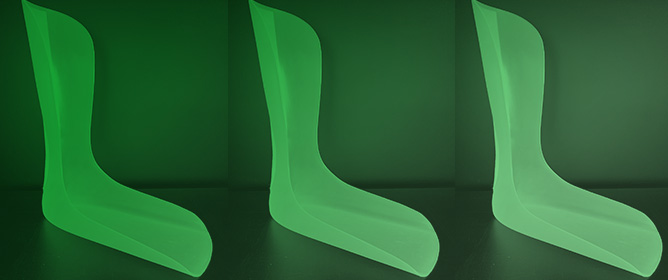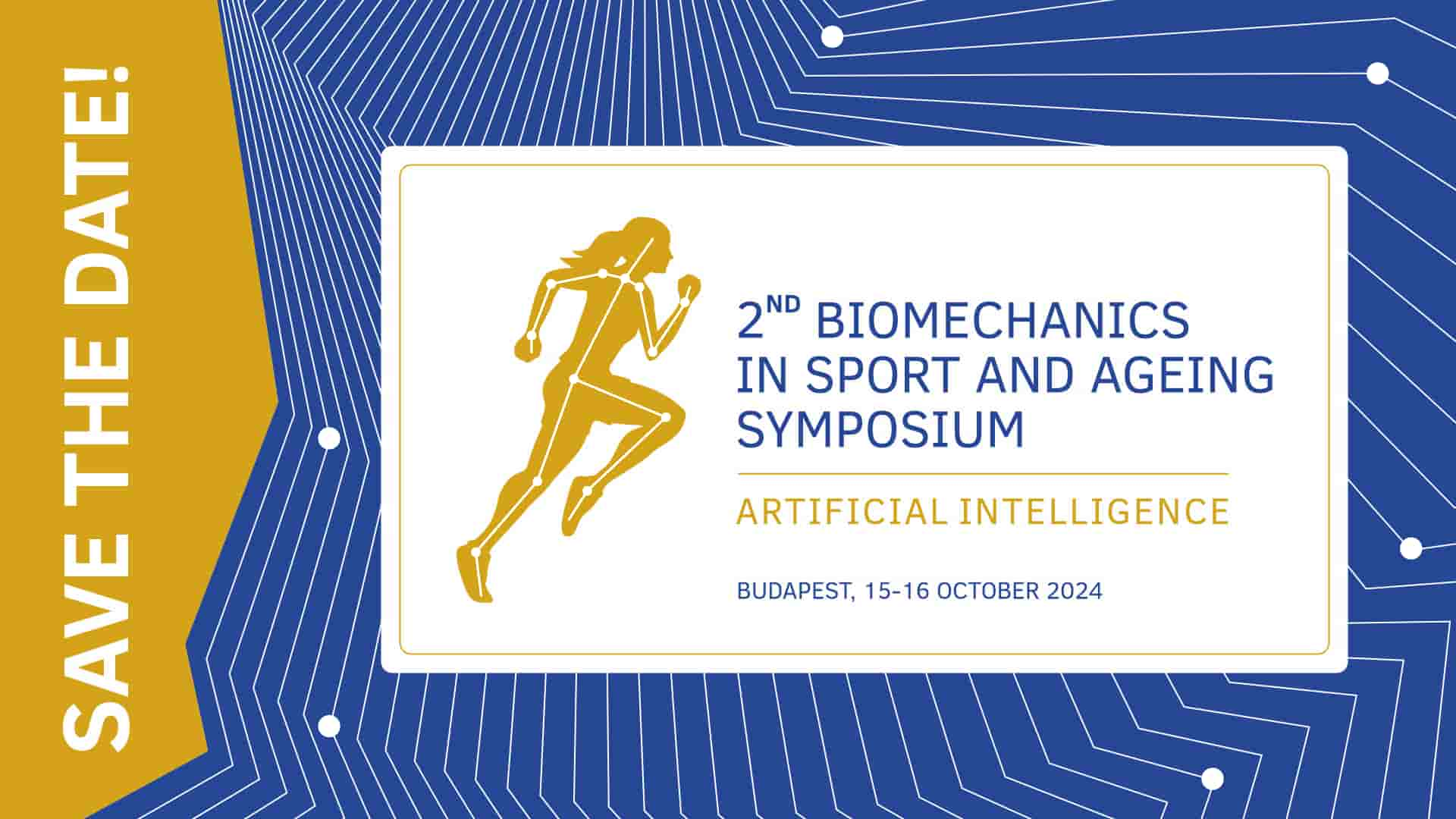Journal Description
Biomechanics
Biomechanics
is an international, peer-reviewed, open access journal on biomechanics research published quarterly online by MDPI.
- Open Access— free for readers, with article processing charges (APC) paid by authors or their institutions.
- High Visibility: indexed within Scopus, EBSCO, and other databases.
- Rapid Publication: manuscripts are peer-reviewed and a first decision is provided to authors approximately 23.8 days after submission; acceptance to publication is undertaken in 7.7 days (median values for papers published in this journal in the second half of 2023).
- Recognition of Reviewers: APC discount vouchers, optional signed peer review, and reviewer names published annually in the journal.
Latest Articles
Impact of Obesity on Foot Kinematics: Greater Arch Compression and Metatarsophalangeal Joint Dorsiflexion despite Similar Joint Coupling Ratios
Biomechanics 2024, 4(2), 235-245; https://doi.org/10.3390/biomechanics4020013 - 16 Apr 2024
Abstract
This study investigates the sagittal plane dynamics of the foot, particularly the metatarsophalangeal (MTP) joint and medial longitudinal arch (MLA) movements, in relation to obesity and foot health. The kinematics of the MTP and arch joints were measured in 17 individuals with class
[...] Read more.
This study investigates the sagittal plane dynamics of the foot, particularly the metatarsophalangeal (MTP) joint and medial longitudinal arch (MLA) movements, in relation to obesity and foot health. The kinematics of the MTP and arch joints were measured in 17 individuals with class 2–3 obesity (BMI > 35 kg/m²) and 10 normal-weight individuals (BMI ≤ 24.9 kg/m²) using marker-based tracking. Analysis was conducted during heel lifting while seated and during walking at self-selected speeds. The results indicated that obese participants exhibited 20.92% greater MTP joint dorsiflexion at the end of the push-off phase and 19.84% greater MLA compression during the stance phase compared to normal-weight controls. However, no significant differences were found in the kinematic joint coupling ratio. While these findings reveal the different biomechanical behaviors of the MTP joint and MLA in obese compared to normal-weight individuals, it is important to interpret the implications of these differences with caution. This study identifies specific biomechanical variations that could be further explored to understand their potential impact on foot health in obese populations.
Full article
(This article belongs to the Special Issue Personalized Biomechanics and Orthopedics of the Lower Extremity)
►
Show Figures
Open AccessReview
Wheelchair Badminton: A Narrative Review of Its Specificities
by
Ilona Alberca, Bruno Watier, Félix Chénier, Florian Brassart and Arnaud Faupin
Biomechanics 2024, 4(2), 219-234; https://doi.org/10.3390/biomechanics4020012 - 02 Apr 2024
Abstract
This narrative review aims to provide a comprehensive overview of the scientific literature on wheelchair badminton and its distinctive aspects, encompassing abilities and disabilities, propulsion technique, and the use of a racket. The relatively young history of wheelchair badminton is reflected in the
[...] Read more.
This narrative review aims to provide a comprehensive overview of the scientific literature on wheelchair badminton and its distinctive aspects, encompassing abilities and disabilities, propulsion technique, and the use of a racket. The relatively young history of wheelchair badminton is reflected in the scarcity of scientific studies within this domain, highlighting the need for further investigation. The review systematically covers existing articles on wheelchair badminton, offering a nearly exhaustive compilation of knowledge in this area. Findings suggest that athletes with abdominal capacities engage in more intense matches with a higher frequency of offensive shots compared to athletes with little or no abdominal capacities. Moreover, backward propulsion induces higher cardiorespiratory responses, overall intensity of effort, physiological stress, metabolic load, and rating of perceived exertion, particularly at high imposed rolling resistance or speeds, and makes it difficult to generate sufficient forces on the handrim, requiring adjustments in the kinematics of propulsion techniques, particularly at high rolling resistances or speeds, potentially leading to performance decrements. The use of a badminton racket further increases generated forces while decreasing the efficiency of propulsion and modifying the propulsion technique with shorter and quicker pushes, potentially impacting performance. Further research is imperative to explore additional perspectives, address existing gaps, and expand the scope of study within the wheelchair badminton domain. This narrative review serves as a foundation for future investigations, emphasizing the necessity of continued research to enhance our understanding of wheelchair badminton.
Full article
(This article belongs to the Collection Locomotion Biomechanics and Motor Control)
►▼
Show Figures
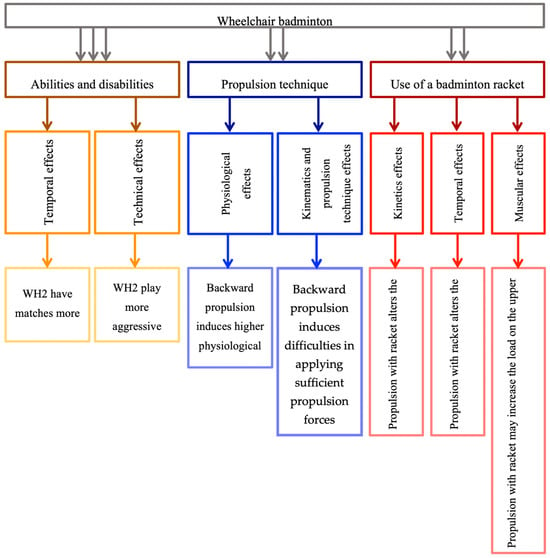
Figure 1
Open AccessSystematic Review
Gait Biomechanical Parameters Related to Falls in the Elderly: A Systematic Review
by
Jullyanne Silva, Tiago Atalaia, João Abrantes and Pedro Aleixo
Biomechanics 2024, 4(1), 165-218; https://doi.org/10.3390/biomechanics4010011 - 05 Mar 2024
Abstract
According to the World Health Organization, one-third of elderly people aged 65 or over fall annually, and this number increases after 70. Several gait biomechanical parameters were associated with a history of falls. This study aimed to conduct a systematic review to identify
[...] Read more.
According to the World Health Organization, one-third of elderly people aged 65 or over fall annually, and this number increases after 70. Several gait biomechanical parameters were associated with a history of falls. This study aimed to conduct a systematic review to identify and describe the gait biomechanical parameters related to falls in the elderly. MEDLINE Complete, Cochrane, Web of Science, and CINAHL Complete were searched for articles on 22 November 2023, using the following search sentence: (gait) AND (fall*) AND ((elder*) OR (old*) OR (senior*)) AND ((kinematic*) OR (kinetic*) OR (biomechanic*) OR (electromyogram*) OR (emg) OR (motion analysis*) OR (plantar pressure)). This search identified 13,988 studies. From these, 96 were selected. Gait speed, stride/step length, and double support phase are gait biomechanical parameters that differentiate fallers from non-fallers. Fallers also tended to exhibit higher variability in gait biomechanical parameters, namely the minimum foot/toe clearance variability. Although the studies were scarce, differences between fallers and non-fallers were found regarding lower limb muscular activity and joint biomechanics. Due to the scarce literature and contradictory results among studies, it is complex to draw clear conclusions for parameters related to postural stability. Minimum foot/toe clearance, step width, and knee kinematics did not differentiate fallers from non-fallers.
Full article
(This article belongs to the Special Issue Gait and Balance Control in Typical and Special Individuals)
►▼
Show Figures
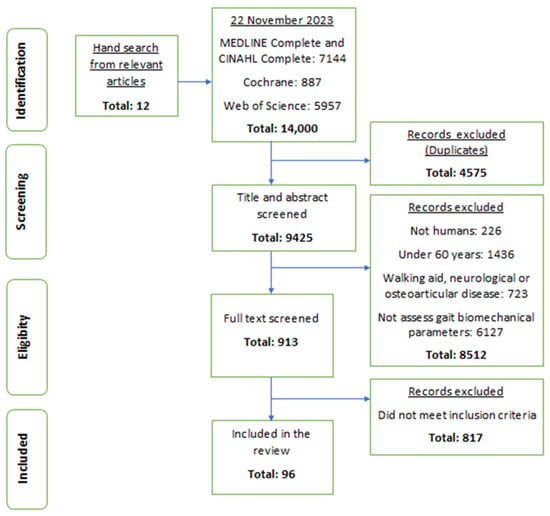
Figure 1
Open AccessArticle
Investigating Biomechanical Postural Control Strategies in Healthy Aging Adults and Survivors of Stroke
by
Lara A. Thompson, Roni A. Romero Melendez and Ji Chen
Biomechanics 2024, 4(1), 153-164; https://doi.org/10.3390/biomechanics4010010 - 05 Mar 2024
Abstract
As the aging populations, both nationwide and worldwide, rapidly increase, falls leading to unintentional injury and death subsequently increase. Thus, developing an understanding of biomechanical postural control strategies used to maintain balance in aging healthy adults, and those that have suffered stroke, are
[...] Read more.
As the aging populations, both nationwide and worldwide, rapidly increase, falls leading to unintentional injury and death subsequently increase. Thus, developing an understanding of biomechanical postural control strategies used to maintain balance in aging healthy adults, and those that have suffered stroke, are critical. Here, we were interested in how one’s body segments stabilize relative to one another, and in space, in order to maintain balance. To accomplish this goal, we studied 30 healthy individuals and 8 survivors of stroke between 60 and 85 years old, both before and after several weeks of sensory training. Motion capture data were acquired to assess participants’ body kinematics during walking: forward (easiest), forward-tandem, backward, and backward-tandem walking (most challenging). Deviations (via the observation of the absolute angle with deviations, or AADs) of the head, thorax, and lumbar areas relative to an earth vertical reference, as well as how one body segment stabilized in space or relative to the inferior body segment (via the observation of anchoring indices, or AIs), were explored. The results provide metrics (AADs and AIs) that can assess aging posture. Further, the results show an initial indication that, for aging individuals, training could lead to improved head and body stabilization in space.
Full article
(This article belongs to the Special Issue Encouraging More Youthful Mechanics and Energetics of Locomotion through Intervention for Older Adults)
►▼
Show Figures
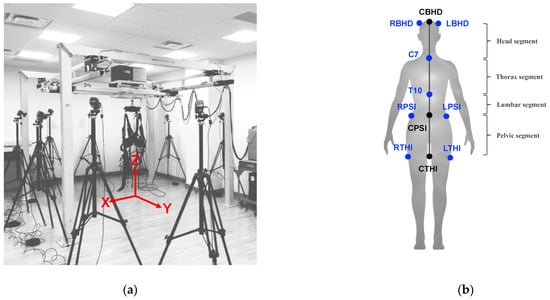
Figure 1
Open AccessArticle
Influence of the Stick Grasping in Sprint and Change of Direction Performance in Elite Youth Rink Hockey Players
by
Jordi Arboix-Alió, Guillem Trabal, Bernat Buscà, Dani Moreno-Galcerán, Bernat de Pablo, Hugo Sarmento and Vasco Vaz
Biomechanics 2024, 4(1), 144-152; https://doi.org/10.3390/biomechanics4010009 - 01 Mar 2024
Abstract
This study aimed to investigate the influence of stick grasping on the performance of elite youth rink hockey players in 10 m linear sprints and 180° change of direction (COD) tasks. Forty-nine rink hockey players (age = 18.40 ± 2.12 year; body mass
[...] Read more.
This study aimed to investigate the influence of stick grasping on the performance of elite youth rink hockey players in 10 m linear sprints and 180° change of direction (COD) tasks. Forty-nine rink hockey players (age = 18.40 ± 2.12 year; body mass = 73.52 ± 6.02 kg; height = 1.82 ± 0.07 m; BMI = 23.61 ± 1.69; sports experience = 6.42 ± 1.41 years; 4.89 ± 0.68 years’ post-peak height velocity) participated in this cross-sectional study. Measurements included 10 m sprint time and COD 180° performance with and without stick grasping. Results revealed non-significant differences when carrying a stick in the 10 m linear sprint (1.90 s ± 0.08 with stick vs. 1.89 s ± 0.08 without stick; p = 0.71; d = 0.05), neither did COD 180° for the left limb (2.75s ± 0.11 with stick vs. 2.76 s ± 0.11 without stick; p = 0.91; d = 0.02). However, for the right limb, significantly better performance in COD 180° was found when players held the stick (2.72 s ± 0.11 with stick vs. 2.75 s ± 0.09 without stick; p = 0.03; d = 0.32). These findings imply that the distinctive biomechanics and requirements of rink hockey, especially the lateral movements inherent in skating, might alleviate the negative impacts associated with implement grasping observed in other sports. This study highlights that stick grasping did not hinder COD ability and may even have a facilitating effect on certain movements, emphasizing the importance of considering sport-specific biomechanics in rink hockey performance analysis.
Full article
(This article belongs to the Collection Locomotion Biomechanics and Motor Control)
►▼
Show Figures
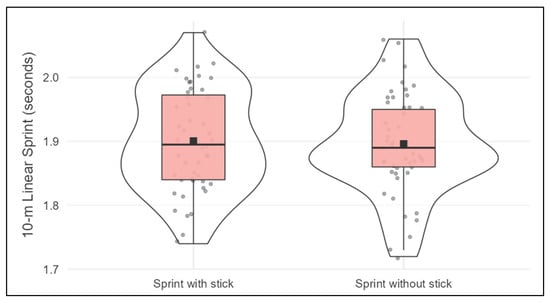
Figure 1
Open AccessReview
Does Producing Scientific Articles Lead to Paralympic Podiums?
by
Francine Pilon and François Prince
Biomechanics 2024, 4(1), 123-143; https://doi.org/10.3390/biomechanics4010008 - 01 Mar 2024
Abstract
The Olympic/Paralympic Games are world events that promote countries and their participants, and more particularly, those winning medals. The potential link between a country’s scientific productivity and its podium wins remains unknown for the Paralympic Games. This study aimed to (1) quantify the
[...] Read more.
The Olympic/Paralympic Games are world events that promote countries and their participants, and more particularly, those winning medals. The potential link between a country’s scientific productivity and its podium wins remains unknown for the Paralympic Games. This study aimed to (1) quantify the link between the production of Paralympic scientific articles and the medals won by countries during Summer/Winter Paralympic Games between 2012 and 2022, and (2) select the five most important articles published for all Paralympic sports. A bibliographic search of the Web of Science, PubMed, and Google Scholar databases was conducted. From the 1351 articles identified, 525 fulfilled the inclusion/exclusion criteria. The results showed a greater (7x) production of scientific articles relating to the Summer Paralympics compared to those relating to the Winter Paralympics. For the Summer Paralympics, there was a strong correlation (r = 0.79) between the number of medals and the number of scientific articles produced by a given country, while a low correlation (r = 0.12) was observed for the Winter Paralympics. Biomechanics-related articles represent almost 50% of the overall Paralympic publications. In conclusion, there is a strong link between scientific productivity and the number of medals won for the 2012–2022 Paralympic Games. Parasport Federations are strongly encouraged to promote the publication of more Paralympic research articles.
Full article
(This article belongs to the Section Sports Biomechanics)
►▼
Show Figures
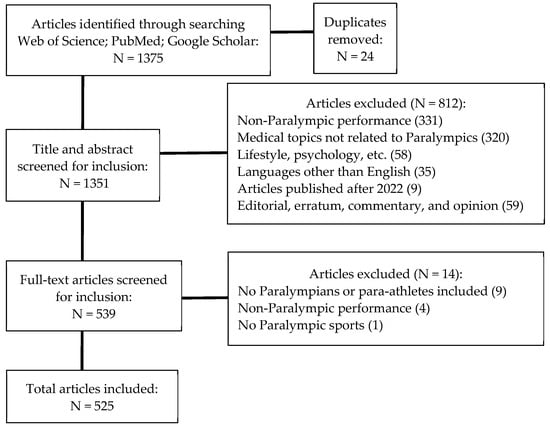
Figure 1
Open AccessArticle
The Effect of Compression Garments on Biomechanical and Physiological Factors
by
Andrew Craig-Jones, Daniel R. Greene, Jonathan J. Ruiz-Ramie, James W. Navalta and John A. Mercer
Biomechanics 2024, 4(1), 109-122; https://doi.org/10.3390/biomechanics4010007 - 23 Feb 2024
Abstract
To the purpose of this study was to compare muscle oscillation, muscle activation time, and oxygen consumption while wearing compression pants vs. a control garment during running. Methods. Eleven injury-free and recreationally active participants (26.73 ± 12.74 years) were recruited for this study.
[...] Read more.
To the purpose of this study was to compare muscle oscillation, muscle activation time, and oxygen consumption while wearing compression pants vs. a control garment during running. Methods. Eleven injury-free and recreationally active participants (26.73 ± 12.74 years) were recruited for this study. Participants ran in full-leg compression pants (COMP) and a loose-fitting control garment (CON). Participants ran for 6 min at three submaximal speeds: preferred speed (PS), preferred speed minus 10% (PS − 10%), and preferred speed plus 10% (PS + 10%). The muscle activity of the leg was measured through electromyography (EMG). Muscle oscillation (MO) was measured with accelerometers attached to the thigh and shank. The rate of oxygen consumption (
(This article belongs to the Topic Endurance and Ultra-Endurance: Implications of Training, Recovery, Nutrition, and Technology on Performance and Health)
►▼
Show Figures

Figure 1
Open AccessArticle
Two Repetitions May Be Enough! Reliability of Movement Timing in Physical Fitness Exercises Performed by Young, Trained Adults Using Inertial Sensors
by
Analina Emmanouil, Elissavet Rousanoglou and Konstantinos Boudolos
Biomechanics 2024, 4(1), 84-108; https://doi.org/10.3390/biomechanics4010006 - 19 Feb 2024
Abstract
This study aimed to determine the minimum number of repetitions for a high reliability of movement timing in fundamental physical fitness exercises using inertial sensors. Fifteen young men and fifteen women performed eight exercises (two-leg hop, forward lunge, squat, sit-up, shoulder abduction, hip
[...] Read more.
This study aimed to determine the minimum number of repetitions for a high reliability of movement timing in fundamental physical fitness exercises using inertial sensors. Fifteen young men and fifteen women performed eight exercises (two-leg hop, forward lunge, squat, sit-up, shoulder abduction, hip abduction, back extension, and push-up) (preferred tempo, 3 trials, 20 repetitions per trial). The movement timing (cycle of movement in seconds and its phases in seconds and %tcycle) was tested for intra- and inter-trial reliability (SPSS 28.0, p ≤ 0.05). Just two repetitions were adequate for excellent intra- and inter-trial relative reliability (ICCs ≥ 0.75, isolated exceptions only for durations expressed as %tcycle, in only three out of the eight exercises: hip abduction, back extension, and push-up), as well as for high absolute intra- and inter-trial reliability (average SEM% at 5.9%, respectively, and 6.8% and average MDC95% at 13.7% and 15.9%, respectively, which was consistently higher than the upper boundary limit of SEM%, and a rather low CV% ranging from 1.5% to 4.9% and averaging at 3.1%). A total of four repetitions, excluding the initial and the final one, appears adequate for high overall reliability of movement timing in the eight physical fitness exercises examined.
Full article
(This article belongs to the Section Gait and Posture Biomechanics)
►▼
Show Figures

Figure 1
Open AccessArticle
Inertial Sensing of the Abdominal Wall Kinematics during Diaphragmatic Breathing in Head Standing
by
Elissavet Rousanoglou, Apostolina Foskolou, Analina Emmanouil and Konstantinos Boudolos
Biomechanics 2024, 4(1), 63-83; https://doi.org/10.3390/biomechanics4010005 - 02 Feb 2024
Cited by 1
Abstract
Head standing (HS) in concurrence with diaphragmatic breathing is an atypical deviation from daily activity, yet commonly practiced. The study aimed at the inertially sensed effect of diaphragmatic versus normal breathing on the abdomen wall kinematics during HS. Twenty-eight men and women maintained
[...] Read more.
Head standing (HS) in concurrence with diaphragmatic breathing is an atypical deviation from daily activity, yet commonly practiced. The study aimed at the inertially sensed effect of diaphragmatic versus normal breathing on the abdomen wall kinematics during HS. Twenty-eight men and women maintained HS and erect standing (ES) under normal and diaphragmatic breathing. An inertial sensor (LORD MicroStrain®, 3DM-GX3®-45, 2 cm above the umbilicus, 100 Hz, MicroStrain, Williston, VT, USA) recorded the 3D abdomen wall angular displacement (AD) (bandpass filter (0.1–0.5 Hz)). ANOVAs (p ≤ 0.05, SPSS 28.0) were applied to the extracted variables (AD path: magnitude, individual variability-%CVind, and diaphragmatic to normal ratio). Reliability measures (ICC and %SEM) and the minimal detectable change (%MDC90) were estimated. Diaphragmatic breathing increased the AD path (p ≤ 0.05) with the diaphragmatic to normal ratio being lower in HS (p ≤ 0.05). The similar AD time series (cross-correlations at p ≤ 0.05) and the ICCs (>0.80) indicated excellent reliability with the similar across conditions %CVind (p ≤ 0.05), further enhancing reliability. The %MDC90 was consistently higher than the %SEM upper boundary, indicating the differences as “real” ones. The results contribute to the limited data concerning a widely practiced atypical deviation from daily activity, as HS in concurrence with diaphragmatic breathing.
Full article
(This article belongs to the Special Issue Inertial Sensor Assessment of Human Movement)
►▼
Show Figures
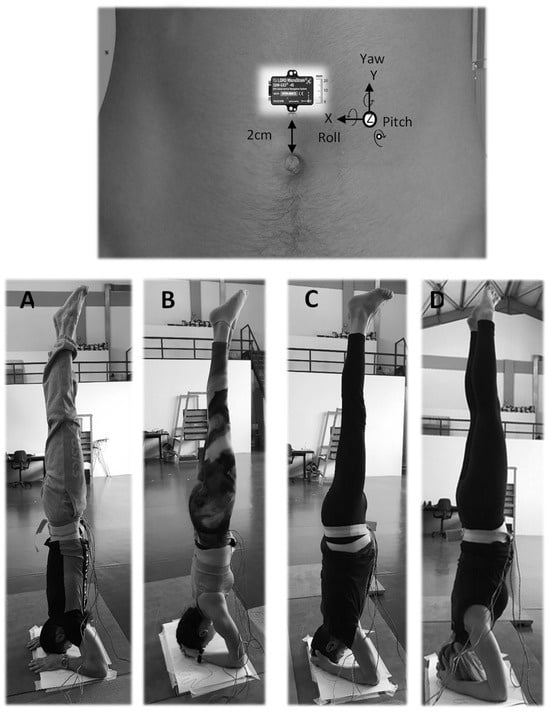
Figure 1
Open AccessArticle
Lower Limb Cross-Over Effects on Postural Control: Impact of Proximal and Distal Muscle Fatigue
by
Morteza Farivar, Sara Harris, Anton Agana and Adam C. King
Biomechanics 2024, 4(1), 50-62; https://doi.org/10.3390/biomechanics4010004 - 02 Feb 2024
Cited by 1
Abstract
The purpose of this study was to examine the cross-over influence of lower limb fatigue on postural control. Using two experiments, cross-over fatigue was investigated using a proximal (Experiment 1—single-leg squat) and distal (Experiment 2—calf raise) muscle group. In Experiment 1, 15 healthy
[...] Read more.
The purpose of this study was to examine the cross-over influence of lower limb fatigue on postural control. Using two experiments, cross-over fatigue was investigated using a proximal (Experiment 1—single-leg squat) and distal (Experiment 2—calf raise) muscle group. In Experiment 1, 15 healthy young participants underwent a single-leg standing task on both the right and left leg, with variations of having eyes open or closed and on stable or unstable surfaces, performing each task for 30 s. For Experiment 2, 20 individuals performed single-leg balance testing for the right and left leg and stable and unstable surfaces. Center-of-pressure data were collected during the balance tasks and were analyzed with linear (standard deviation) and nonlinear (detrended fluctuation analysis) metrics. The results lacked significant differences (p > 0.05) for cross-over fatigue effects on the non-exercised limb, which exhibited similar levels of postural sway between the pre- and post-fatigue balance tests. These tasks may have lacked an appropriate level of duration or intensity to cause a significant effect of central fatigue on the nervous system. The findings underscore the need to better understand how a specific fatiguing task during unilateral rehabilitation may alter postural control.
Full article
(This article belongs to the Section Gait and Posture Biomechanics)
►▼
Show Figures
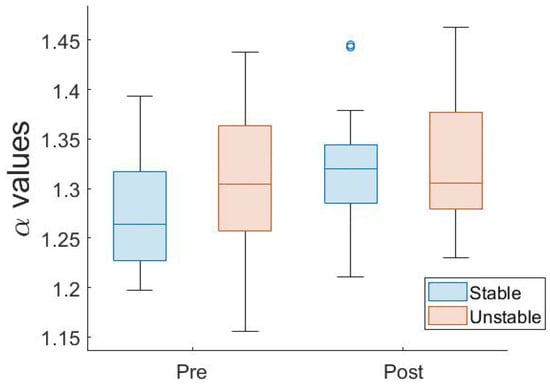
Figure 1
Open AccessSystematic Review
Outcomes and Safety with Utilization of Metallic Midfoot Wedges in Foot and Ankle Orthopedic Surgery: A Systematic Review of the Literature
by
Grayson M. Talaski, Anthony Baumann, Bshara Sleem, Kempland C. Walley, Albert T. Anastasio, Ken Gall and Samuel B. Adams
Biomechanics 2024, 4(1), 34-49; https://doi.org/10.3390/biomechanics4010003 - 17 Jan 2024
Abstract
The use of midfoot wedges for the correction of flatfeet disorders, such as progressive collapsing foot disorder, has increased greatly in recent years. However, the wedge material/composition has yet to be standardized. Metallic wedges offer advantages such as comparable elasticity to bone, reduced
[...] Read more.
The use of midfoot wedges for the correction of flatfeet disorders, such as progressive collapsing foot disorder, has increased greatly in recent years. However, the wedge material/composition has yet to be standardized. Metallic wedges offer advantages such as comparable elasticity to bone, reduced infection risk, and minimized osseous resorption, but a comprehensive review is lacking in the literature. Therefore, the objective of this systematic review was to organize all studies pertaining to the use of metallic wedges for flatfoot correction to better understand their efficacy and safety. This systematic review adhered to PRISMA guidelines, and articles were searched in multiple databases (PubMED, SPORTDiscus, CINAHL, MEDLINE, and Web of Science) until August 2023 using a defined algorithm. Inclusion criteria encompassed midfoot surgeries using metallic wedges, observational studies, and English-language full-text articles. Data extraction, article quality assessment, and statistical analyses were performed. Among 11 included articles, a total of 444 patients were assessed. The average follow-up duration was 18 months. Radiographic outcomes demonstrated that patients who received metallic wedges experienced improvements in lateral calcaneal pitch angle and Meary’s angle, with an enhancement of up to 15.9 degrees reported in the latter. Success rates indicated superior outcomes for metallic wedges (99.3%) compared to bone allograft wedges (89.9%), while complications were generally minor, including hardware pain and misplacement. Notably, there were no infection complications due to the inert nature of the metallic elements. This review summarizes the effectiveness, success rates, and safety of metallic wedges for flatfoot correction. Radiographic improvements and high success rates highlight their efficacy. Minor complications, including pain and mispositioning, were reported, but the infection risk remained low. Our results demonstrate that metallic midfoot wedges may be a viable option over allograft wedges with proper planning. Future research should prioritize long-term studies and standardized measures.
Full article
(This article belongs to the Section Gait and Posture Biomechanics)
►▼
Show Figures
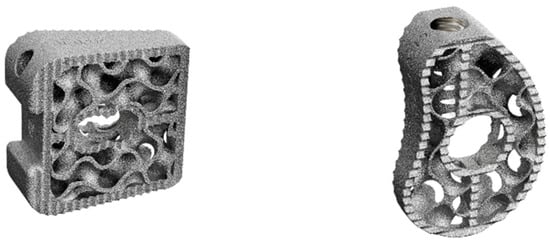
Figure 1
Open AccessArticle
The Impact of Different Self-Selected Walking Speeds on Muscle Synergies in Transfemoral Amputees during Transient-State Gait
by
Pouyan Mehryar, Mohammad Shourijeh, Tahmineh Rezaeian, Aminreza Khandan, Neil Messenger, Rory O’Connor, Farzam Farahmand and Abbas Dehghani-Sanij
Biomechanics 2024, 4(1), 14-33; https://doi.org/10.3390/biomechanics4010002 - 11 Jan 2024
Abstract
Facing above-knee amputation poses a significant hurdle due to its profound impact on walking ability. To overcome this challenge, a complex adaptation strategy is necessary at the neuromuscular level to facilitate safe movement with a prosthesis. Prior research conducted on lower-limb amputees has
[...] Read more.
Facing above-knee amputation poses a significant hurdle due to its profound impact on walking ability. To overcome this challenge, a complex adaptation strategy is necessary at the neuromuscular level to facilitate safe movement with a prosthesis. Prior research conducted on lower-limb amputees has shown a comparable amount of intricacy exhibited by the neurological system, regardless of the level of amputation and state of walking. This research investigated the differences in muscle synergies among individuals with unilateral transfemoral amputations during walking at three different speeds of transient-state gait. Surface electromyography was recorded from eleven male transfemoral amputees’ intact limbs (TFA), and the concatenated non-negative matrix factorization technique was used to identify muscle synergy components, synergy vectors (S), and activation coefficient profiles (C). Results showed varying levels of correlation across paired-speed comparisons in TFA, categorized as poor (S1), moderate (S3 and S4), and strong (S2). Statistically significant differences were observed in all activation coefficients except C3, particularly during the stance phase. This study can assist therapists in understanding muscle coordination in TFA during unsteady gait, contributing to rehabilitation programs for balance and mobility improvement, and designing myoelectric prosthetic systems to enhance their responsiveness to trips or falls.
Full article
(This article belongs to the Special Issue Effect of Neuromuscular Deficit on Gait)
►▼
Show Figures
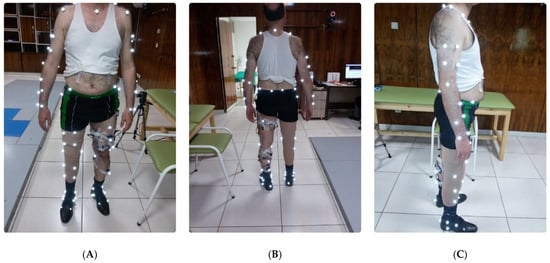
Figure 1
Open AccessArticle
Intra-Day and Inter-Day Reliability and Usefulness of Performance, Kinetic and Kinematic Variables during Drop Jumping in Hurling Players
by
Luke Atkins, Colin Coyle, Jeremy Moody, Rodrigo Ramirez-Campillo and Paul J. Byrne
Biomechanics 2024, 4(1), 1-13; https://doi.org/10.3390/biomechanics4010001 - 10 Jan 2024
Abstract
The aim of this study was to estimate the intra-day and inter-day reliability and usefulness of performance (Jump height (JH), ground contact time (GCT) and reactive strength index (RSI)), kinetic (force, power, eccentric rate of force development [E-RFD] and leg stiffness [LS]) and
[...] Read more.
The aim of this study was to estimate the intra-day and inter-day reliability and usefulness of performance (Jump height (JH), ground contact time (GCT) and reactive strength index (RSI)), kinetic (force, power, eccentric rate of force development [E-RFD] and leg stiffness [LS]) and kinematic (velocity) variables during drop jumping (DJ) in hurling players. Seventeen (n = 17; mean ± SD; age = 23.35 ± 5.78 years, height = 178.35 ± 6.30 cm, body mass = 78.62 ± 8.06 kg) male club-level hurling players completed two maximal DJs from 0.20, 0.30, 0.40, 0.50 and 0.60 m drop heights on three testing days separated by 5–9 days of rest. Reliability was assessed using the coefficient of variation percentage (CV% ≤ 15%) and intraclass correlation coefficient (ICC > 0.70). For intra-day reliability, GCT (0.40 m, 0.50 m and 0.60 m), peak force (absolute and relative) (0.40 m and 0.50 m) and leg stiffness (0.40 m and 0.50 m) were found to be unreliable (ICC = 0.32–0.68 and CV% = 3.67–11.83%) from those specific drop heights. All other variables were found to be reliable (ICC = 0.72–0.98 and CV% = 1.07–14.02%) intra-day. All variables were found to be reliable (ICC = 0.72–0.96 and CV% = 2.57–14.68%) inter-day except for relative peak force and absolute and relative eccentric RFD (0.30 m and 0.40 m) (ICC = 0.68–0.90 and CV% = 7.76–16.47%). Practitioners have multiple reliable DJ performance, kinetic and kinematic variables for performance testing and training purposes.
Full article
(This article belongs to the Topic Endurance and Ultra-Endurance: Implications of Training, Recovery, Nutrition, and Technology on Performance and Health)
►▼
Show Figures

Figure 1
Open AccessArticle
How Does the Micro-Groove Profile Influence the Mechanics of Taper Junction in Hip Implants? A Finite Element Study
by
Akash Kalwar, Mohsen Feyzi and Reza Hashemi
Biomechanics 2023, 3(4), 596-607; https://doi.org/10.3390/biomechanics3040048 - 07 Dec 2023
Abstract
This study aims to investigate the effect of ridged (micro-grooved) surface finish over the trunnion surface on the mechanics (stress, strain, and deformation) of the head–neck taper interface in hip implants. Using finite element modelling, the study focused on the geometric parameters of
[...] Read more.
This study aims to investigate the effect of ridged (micro-grooved) surface finish over the trunnion surface on the mechanics (stress, strain, and deformation) of the head–neck taper interface in hip implants. Using finite element modelling, the study focused on the geometric parameters of such micro-grooves to study how they would mechanically affect stress and deformation fields after the assembly procedure. As such, five different 2D models with varying micro-groove height and spacing were produced and assembled under an impaction assembly force of 4 kN in a 32 mm CoCrMo head engaged with a 12/14 Ti-6Al-4V neck. The results showed that lower von Mises stresses could be induced by either an increase or decrease in spacing against the base model (Model 1), which probably signifies that the relationship between the ridge spacing and stress may depend on the level of spacing. It was concluded that the geometrical parameters of the ridges (and their non-linear interactions) impact not only the stress and strain fields but also the assembly loading time at which the maximal stress and plastic deformation occur.
Full article
(This article belongs to the Section Gait and Posture Biomechanics)
►▼
Show Figures

Figure 1
Open AccessArticle
Estimation of the Effects of Achilles Tendon Geometry on the Magnitude and Distribution of Local Strain: A Finite Element Analysis
by
Shota Enomoto and Toshiaki Oda
Biomechanics 2023, 3(4), 583-595; https://doi.org/10.3390/biomechanics3040047 - 04 Dec 2023
Abstract
We investigated the influence of Achilles tendon (AT) geometry on local-strain magnitude and distribution during loading, using finite element analysis. We calculated the following eight AT parameters for 18 healthy men: thickness and width of the most distal part, minimum cross-sectional area (mCSA),
[...] Read more.
We investigated the influence of Achilles tendon (AT) geometry on local-strain magnitude and distribution during loading, using finite element analysis. We calculated the following eight AT parameters for 18 healthy men: thickness and width of the most distal part, minimum cross-sectional area (mCSA), and most proximal part; length; and position of the mCSA. To investigate the effect of AT geometry on the magnitude and distribution of local strain, we created three-dimensional numerical models by changing the AT parameter values for every one standard deviation (SD) in the range of ±2 SD. A 4000 N lengthening force was applied to the proximal surface of all the models. The mean first principal strain (FPS) was determined every 3% of the length. The highest FPS in each model was mainly observed in the proximal regions; the 86–89% site (the most proximal site was set at 100%) had the highest number of models with the highest FPS (nine models). The highest FPS was observed in the model with a distal thickness of −2 SD, which was 27.1% higher than that of the standard model observed in the 2–5% site. Therefore, the AT geometry influences local-strain magnitude and distribution during loading.
Full article
(This article belongs to the Section Tissue and Vascular Biomechanics)
►▼
Show Figures
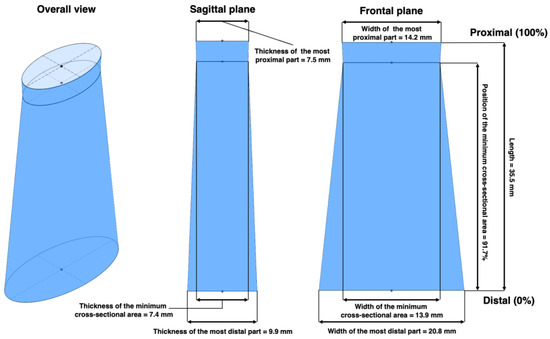
Figure 1
Open AccessArticle
Spatiotemporal Gait Variability in Children Aged 2 to 10 Decreases throughout Pre-Adolescence
by
Bryon C. Applequist, Zachary L. Motz and Anastasia Kyvelidou
Biomechanics 2023, 3(4), 571-582; https://doi.org/10.3390/biomechanics3040046 - 03 Dec 2023
Abstract
Background: Children’s gait is traditionally understood to mature as young as three years old through pre-adolescence. Studies looking at gait biomechanics suggest that gait matures around three years old, while studies investigating gait variability propose a much later maturation. The studies that have
[...] Read more.
Background: Children’s gait is traditionally understood to mature as young as three years old through pre-adolescence. Studies looking at gait biomechanics suggest that gait matures around three years old, while studies investigating gait variability propose a much later maturation. The studies that have examined children’s gait variability did so while the children walked around a track or down hallways that created a discontinuous gait, potentially affecting the measures of variability and the efficacy of the results. Purpose: Therefore, the purpose of our study was to investigate the development of gait dynamics and gait variability in children in a more continuous fashion, in this case, by walking on a treadmill. Methods: To accomplish this, we included four age groups of children, ranging 2–10 years old, walking on a treadmill for at least three minutes while stride time and stride length were collected. Stride time and stride length’s variability was then analyzed using linear (mean, standard deviation, coefficient of variation) and nonlinear (sample entropy, detrended fluctuation analysis) measures across the varying ages of our participants. Results: Interestingly, both the linear and nonlinear variabilities of the stride time and stride length measures decreased as the groups of children got older. Specifically, CV ST (2–3 (9.3 ± 4%), 8–10 (3.6 ± 0.7%), p < 0.05) and CV SL (2–3 (11.4 ± 3%), 8–10 (4.6 ± 1%), p < 0.05) were our strongest linear measures, and DFA α ST (2–3 (0.97 ± 0.12), 8–10 (0.82 ± 0.10), p < 0.05) and DFA α SL (2–3 (0.91 ± 0.04), 8–10 (0.81 ± 0.03), p < 0.05) were our strongest nonlinear measures, particularly between the youngest and oldest groups. This trend of variability decreasing with age suggests that as children’s gait matures, their gait becomes more stable and reliable. Significance: Our study rejects the notion that children’s gait is mature by the age of three, as some would suggest. By analyzing the variability of stride time and stride length, we can see that even later into childhood, children’s gait continues to change and evolve.
Full article
(This article belongs to the Special Issue Effect of Neuromuscular Deficit on Gait)
►▼
Show Figures
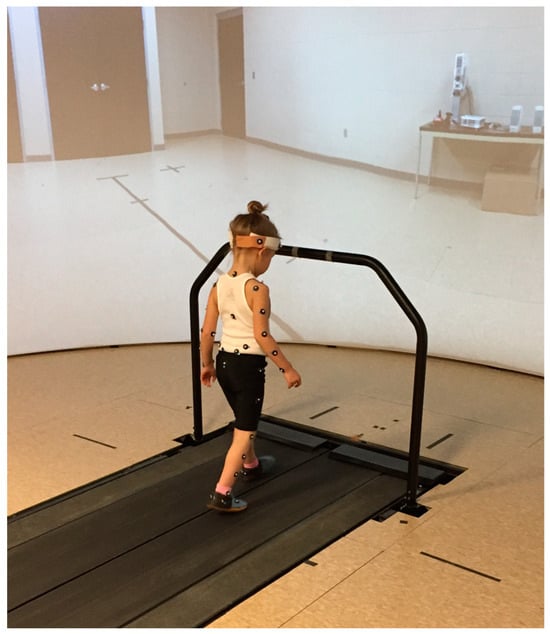
Figure 1
Open AccessCommunication
The Relationship between Balance Confidence and Center of Pressure in Lower-Limb Prosthesis Users
by
Gary Guerra, John D. Smith and Eun-Jung Yoon
Biomechanics 2023, 3(4), 561-570; https://doi.org/10.3390/biomechanics3040045 - 01 Dec 2023
Abstract
Background: Agreement between the activities-specific balance confidence scale (ABC) and center of pressure (CoP) in prosthesis users is still very much unknown. The purpose of this study was to investigate the agreement between ABC and CoP in lower-limb prosthesis users. Methods: Twenty-one individuals
[...] Read more.
Background: Agreement between the activities-specific balance confidence scale (ABC) and center of pressure (CoP) in prosthesis users is still very much unknown. The purpose of this study was to investigate the agreement between ABC and CoP in lower-limb prosthesis users. Methods: Twenty-one individuals with lower-limb prostheses were recruited. Participants were provided with the ABC scale and performed static balance tasks during eyes opened (EO) and eyes closed (EC) conditions whilst standing on a force platform. Pearson product moment coefficients between CoP displacements and ABC scores were performed. Participants were also stratified by those who had better (≥80 on ABC scale) and less (<80 on ABC scale) perceived balance confidence. Displacement was compared using an independent t-test with Cohen’s d to estimate effect size with alpha set at 0.05 for these tests. Results: There was a significant inverse moderate relationship between eyes opened displacement (EOD) (18.3 ± 12.5 cm) and ABC (75.1 ± 18.3%), r = (19)−0.58, p = 0.006, as well as eyes closed displacement (ECD) (37.7 ± 22.1 cm) and ABC, r = (19)−0.56, p = 0.008. No significant difference in EOD (t(19) = 1.36, p = 0.189, d = 0.61) and ECD (t(19) = 1.47, p = 0.156, d = 0.66) was seen between those with greater and less balance confidence. Conclusions: Self-report and performance-based balance outcome measures are recommended when assessing lower-limb prostheses users.
Full article
(This article belongs to the Special Issue Personalized Biomechanics and Orthopedics of the Lower Extremity)
►▼
Show Figures
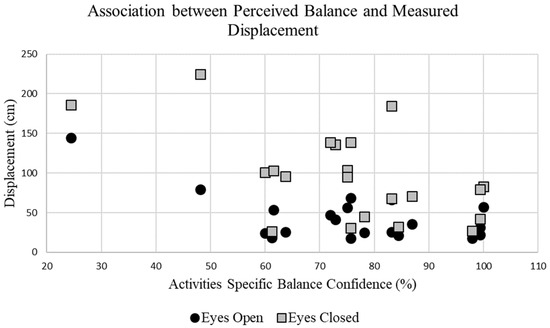
Figure 1
Open AccessArticle
Clinical Validation of Estimated Muscle Activations during Phases of Elderly Gait
by
Athanasios Gkrekidis, Georgios Giarmatzis, Dimitrios Menychtas, Evangelos Karakasis, Vassilios Gourgoulis, Maria Michalopoulou, Ilias Smilios, Helen T. Douda, Georgios Ch. Sirakoulis and Nikolaos Aggelousis
Biomechanics 2023, 3(4), 552-560; https://doi.org/10.3390/biomechanics3040044 - 16 Nov 2023
Abstract
This study validated muscle activation estimations generated by OpenSim during the gait of elderly fallers. Ten healthy elderly participants walked on an instrumented treadmill, monitored by motion capture, force platforms, and 12 surface EMG sensors. Static optimization was used to calculate muscle activations,
[...] Read more.
This study validated muscle activation estimations generated by OpenSim during the gait of elderly fallers. Ten healthy elderly participants walked on an instrumented treadmill, monitored by motion capture, force platforms, and 12 surface EMG sensors. Static optimization was used to calculate muscle activations, evaluated through cosine similarity, comparing them with EMG signals from 12 muscles of the right leg. Findings revealed varied similarity levels across muscles and gait phases. During stance phase, tibialis anterior (TIBA), peroneus longus (PERL), soleus (SOL), gastrocnemius lateralis (GASL), semitendinosus (SEMI), tensor fasciae latae (TFL), and rectus femoris (RECF) demonstrated poor similarity (cosim < 0.6), while gluteus medius (GMED), biceps femoris long head (BFLH), and vastus lateralis (VL) exhibited moderate similarity (0.6 ≤ cosim ≤ 0.8), and gluteus maximus (GMAX) and vastus medialis (VASM) displayed high similarity (cosim > 0.8). During the swing phase, only SOL demonstrated inadequate similarity, while GASL, GMAX, GMED, BFLH, SEMI, TFL, RECF, and VASL exhibited moderate similarity, and TIBA, PERL, and VASM showed high similarity. Comparing the different 10% intervals of the gait cycle generally produced more favorable similarity results. For most of the muscles and intervals, good agreement was found. Moderate agreement was estimated in the cases of TIBA (0–10%), PERL (60–70%), GASL (60–70%), TFL (10–20%), RECF (0–10%, 80–100%), and GMED (50–60%). Bad agreement was found in the cases of SOL (60–70%), GASL (0–10%), and TFL (0–10%). In conclusion, the study’s validation outcomes were acceptable in most cases, underlining the potential for user-friendly musculoskeletal modeling routines to study muscle output during elderly gait.
Full article
(This article belongs to the Special Issue Encouraging More Youthful Mechanics and Energetics of Locomotion through Intervention for Older Adults)
►▼
Show Figures
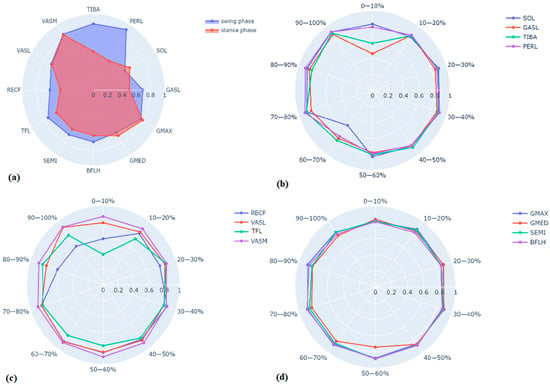
Figure 1
Open AccessArticle
Postural Control Behavior in a Virtual Moving Room Paradigm
by
Hannah R. Freeman, Harish Chander, Sachini N. K. Kodithuwakku Arachchige, Alana J. Turner, J. Adam Jones, Zhujun Pan, Christopher Hudson and Adam C. Knight
Biomechanics 2023, 3(4), 539-551; https://doi.org/10.3390/biomechanics3040043 - 02 Nov 2023
Abstract
Background: Taking inspiration from the classical 1974, “moving room experiment” by Lee and Aronson, a “virtual moving room paradigm (Vroom)” was designed using virtual reality (VR) to assess postural control behavior. Methods: Thirty healthy adults (age: 21 ± 1 years; height: 166.5 ±
[...] Read more.
Background: Taking inspiration from the classical 1974, “moving room experiment” by Lee and Aronson, a “virtual moving room paradigm (Vroom)” was designed using virtual reality (VR) to assess postural control behavior. Methods: Thirty healthy adults (age: 21 ± 1 years; height: 166.5 ± 7.3 cm; mass: 71.7 ± 16.2 kg) were tested for postural stability in a virtual moving room paradigm (Vroom). The Vroom consisted of randomized virtual and visual perturbations of the virtual room moving toward and away from the individual, during both unexpected and expected trials. Objective postural sway variables and subjective experiences to VR using the simulator sickness questionnaire as well as balance confidence scale were also assessed and analyzed using a two way (2 × 2 [2 moving room direction (Toward vs. Away) and 2 knowledge of moving room (unexpected vs. expected)] repeated measures analysis of variance (ANOVA), and a one-way repeated measures ANOVA and paired sample t-test, respectively at an alpha level of 0.05. Results: Significantly greater postural sway was observed when the virtual room moved toward the participant than when moving away, and when it moved unexpectedly, compared with the expected moving room. Significantly improved balance confidence with realistic immersion and without simulator sickness was also observed. Conclusions: Our findings provide evidence indicating that the virtual moving room induces postural perturbations that challenge the postural control system, especially when the moving room is unexpected and moves toward the individual. Additionally, increased balance confidence and realistic immersion in the virtual environment with no adverse effects of simulator sickness were observed, providing evidence for the beneficial effects of the Vroom. Thus, the Vroom can be an easy and cost-effective method to expose individuals to realistic, virtual, and visual perturbations that challenge the postural control system and increase balance confidence, with realistic immersion and without adverse effects.
Full article
(This article belongs to the Section Gait and Posture Biomechanics)
►▼
Show Figures
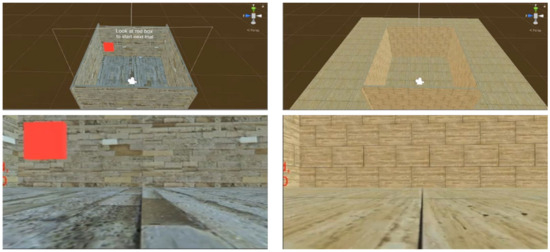
Figure 1
Open AccessArticle
Definition of a Global Coordinate System in the Foot for the Surgical Planning of Forefoot Corrections
by
Sanne Krakers, Anil Peters, Sybrand Homan, Judith olde Heuvel and Gabriëlle Tuijthof
Biomechanics 2023, 3(4), 523-538; https://doi.org/10.3390/biomechanics3040042 - 02 Nov 2023
Abstract
Forefoot osteotomies to improve the alignment are difficult procedures and can lead to a variety of complications. Preoperative planning in three dimensions might assist in the successful management of forefoot deformities. The purpose of this study was to develop a global coordinate system
[...] Read more.
Forefoot osteotomies to improve the alignment are difficult procedures and can lead to a variety of complications. Preoperative planning in three dimensions might assist in the successful management of forefoot deformities. The purpose of this study was to develop a global coordinate system in the foot for the planning of forefoot corrections. Two strategies (CS1 and CS2) were developed for defining a global coordinate system that meets the criteria of being well-defined, robust, highly repeatable, clinically relevant, compatible with foot CT scans, independent of the ankle joint angle, and does not include bones in the forefoot. The absolute angle of rotation was used to quantify repeatability. The anatomical planes of the coordinate systems were visually inspected by an orthopedic surgeon to evaluate the clinical relevancy. The repeatability of CS1 ranged from 0.48° to 5.86°. The definition of CS2 was fully automated and, therefore, had a perfect repeatability (0°). Clinically relevant anatomical planes were observed with CS2. In conclusion, this study presents an automated method for defining a global coordinate system in the foot according to predefined requirements for the planning of forefoot corrections.
Full article
(This article belongs to the Special Issue Personalized Biomechanics and Orthopedics of the Lower Extremity)
►▼
Show Figures
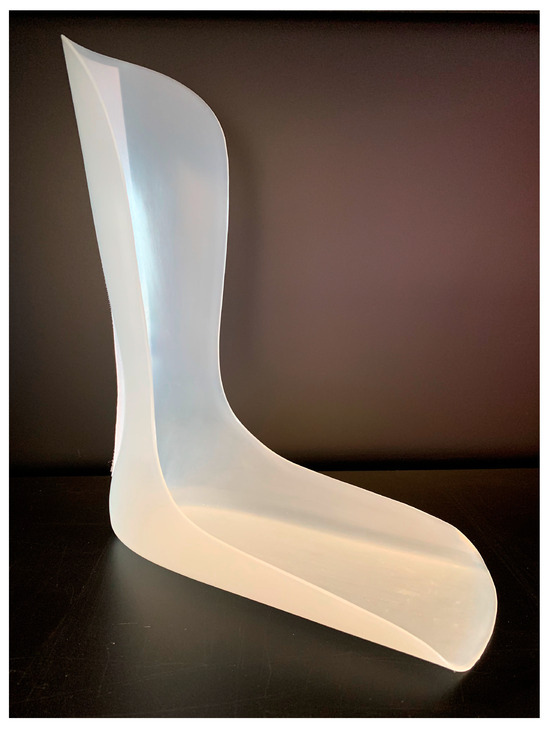
Figure 1
Highly Accessed Articles
Latest Books
E-Mail Alert
News
Topics
Topic in
Biomechanics, Healthcare, IJERPH, Nutrients, Sports, Sensors, Muscles, Foods
Endurance and Ultra-Endurance: Implications of Training, Recovery, Nutrition, and Technology on Performance and Health
Topic Editors: Nicolas Berger, Russ BestDeadline: 31 December 2025

Conferences
Special Issues
Special Issue in
Biomechanics
Effect of Neuromuscular Deficit on Gait
Guest Editor: Pantelis T. NikolaidisDeadline: 30 June 2024
Special Issue in
Biomechanics
Advances in Sport Injuries
Guest Editors: Shaghayegh Bagheri, Francois PrinceDeadline: 31 July 2024
Special Issue in
Biomechanics
Inertial Sensor Assessment of Human Movement
Guest Editors: Alan Godfrey, Elissavet Rousanoglou, John BuckleyDeadline: 31 August 2024
Special Issue in
Biomechanics
Advances in Sensing-Based Animal Biomechanics
Guest Editor: Christian PehamDeadline: 20 October 2024
Topical Collections
Topical Collection in
Biomechanics
Locomotion Biomechanics and Motor Control
Collection Editor: Ka-Chun (Joseph) Siu

